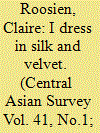| Srl | Item |
| 1 |
ID:
184420


|
|
|
|
|
| Summary/Abstract |
In the 1930s, luxury textiles such as silk and velvet appeared frequently in agitation and propaganda addressed toward women in Uzbekistan. After examining the cultural and material significance of luxury textiles for Central Asian women before collectivization, this article investigates how luxury textiles were used in the effort to mobilize Central Asian women during the years of collectivization and cottonization (c.1929–37). The article concludes with a close reading of several ‘textile-texts’ produced by Central Asian women, focusing particularly on women’s poetry about luxury textiles. The article argues that the discourse of ‘silk and velvet’ tapped into affective resonances rooted in, among other conditions, the local gift economy, Central Asian women’s material conditions, Orientalist discourses and Stakhanovite propaganda. The discourse of silk and velvet thus bolstered hierarchical relations between Central Asian women and the Party–state, while at the same time it generated lateral ties to a public of other Central Asian women. The article relies on research in a variety of archival sources and the Uzbek-language Soviet press, particularly the women’s press.
|
|
|
|
|
|
|
|
|
|
|
|
|
|
|
|
| 2 |
ID:
185882


|
|
|
|
|
| Summary/Abstract |
In contemporary Central Asia, Soviet-era authors are national heroes. Writers’ natal homes have become lovingly curated home-museums; statues of poets bedeck city squares; and schoolchildren write dictations from twentieth-century novels. Less often discussed in public, such writers also once belonged to the Soviet Writers’ Union, many of these poets called themselves “proletarian,” and their novels purported to imagine “revolution.” Poems about tractors rarely appear in today's anthologies, and new editions of 1930s novels excise the once-obligatory references to Stalin. In reaction to their Soviet-era canonization, some writers have been knocked from their pedestals, as recently happened to Hamza in Uzbekistan. Due to the political sensitivity of many Soviet writers in Uzbekistan, most serious scholarly attention has turned, since 1990, toward transitional Jadid writers of the early revolutionary years who were ultimately devoured by the official regime, such as Cho'lpon and Fitrat.
|
|
|
|
|
|
|
|
|
|
|
|
|
|
|
|